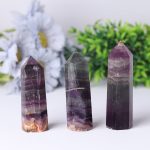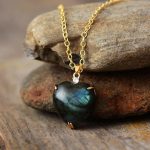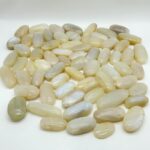Immerse yourself in the captivating world of purple jewel stones, where beauty and brilliance intertwine. These mesmerizing gemstones have captivated hearts and imaginations for centuries, adorning royal crowns, intricate jewelry, and breathtaking works of art. From deep amethysts to vibrant tanzanites, purple jewel stones exude an aura of mystery, elegance, and allure.

History and Origins
The history of purple jewel stones dates back to ancient civilizations, where they were revered for their vibrant hues and perceived mystical powers. Egyptians believed amethysts, with their intense purple color, protected against drunkenness and promoted mental clarity. The Romans associated amethysts with Bacchus, their god of wine, and believed wearing them prevented intoxication.
Over the centuries, purple jewel stones have adorned the crowns of monarchs, symbolized royalty, and served as talismans of protection. Today, they continue to be highly sought after for their beauty, durability, and versatility in jewelry, art, and industry.
Types of Purple Jewel Stones
The world of purple jewel stones encompasses a diverse range of gemstones with unique characteristics and origins. Here are some of the most popular and captivating types:
Amethyst
Amethyst, a variety of quartz, is the most well-known and widely available purple jewel stone. Its name derives from the Greek word amethystos, meaning “not drunken,” reflecting the belief that amethysts could prevent intoxication. Amethysts typically range in color from pale lilac to deep violet, with some exhibiting a reddish hue. They are often cut into faceted gemstones or used in cabochons, where their smooth, rounded surface showcases their natural beauty.
Tanzanite
Tanzanite, a relatively recent discovery, is a gemstone that showcases a captivating blend of purple, blue, and violet hues. It was first discovered in the Merelani Hills of Tanzania in 1967 and was named after the country where it is exclusively found. Tanzanites are prized for their intense color and rarity, making them highly sought after in jewelry.
Alexandrite
Alexandrite, a rare and captivating gemstone, is known for its remarkable ability to change color. It exhibits a deep purple hue under natural light but transforms into a vibrant green or red color under artificial light. This unique optical property, known as pleochroism, makes it a highly prized gemstone for collectors and jewelry enthusiasts.
Charoite
Charoite, a distinctive gemstone discovered in the Chara River Valley of Russia, exhibits a mesmerizing purple and black mottled appearance. Its unique swirling patterns and opaque texture make it a captivating choice for cabochons and ornamental objects.
Purple Spinel
Purple spinel, a member of the spinel gemstone family, offers a vibrant and affordable alternative to purple sapphires. It exhibits a rich purple hue with a slight pinkish undertone and is often used in jewelry and industrial applications.
Properties of Purple Jewel Stones
Purple jewel stones possess a range of physical and chemical properties that contribute to their beauty, durability, and versatility. Here are some key properties:
Hardness
Purple jewel stones generally exhibit high hardness ratings, making them resistant to scratching and wear. Amethysts, for example, have a hardness of 7 on the Mohs scale, while tanzanites have a hardness of 6.5. This durability makes them suitable for use in a wide range of jewelry and ornamental applications.
Refractive Index
The refractive index of a gemstone measures its ability to bend light. Purple jewel stones generally have high refractive indices, which means they have a high degree of brilliance and sparkle. This property enhances their beauty and makes them highly desirable for faceted gemstones.
Color Stability
While most purple jewel stones are stable under normal conditions, some may be sensitive to heat or light. For instance, amethysts can fade when subjected to prolonged exposure to sunlight, while tanzanites can lose their vibrant color if exposed to high temperatures. Proper care and storage are essential to preserve the beauty and value of these gemstones.
Applications of Purple Jewel Stones
The versatility of purple jewel stones extends far beyond their use in jewelry. Their unique properties and captivating hues make them suitable for a wide range of applications, including:
Jewelry
Purple jewel stones are highly prized in jewelry, where they add a touch of elegance and sophistication to any piece. They are featured in a variety of jewelry designs, from delicate earrings to statement necklaces and royal tiaras. The versatility of purple jewel stones allows them to complement a wide range of skin tones and personal styles.
Art and Decor
Purple jewel stones have been used throughout history to create stunning works of art and decorative objects. They are often incorporated into mosaics, sculptures, and ornamental pieces, where their vibrant colors and unique textures add a touch of beauty and intrigue.
Crystals and Healing
In the realm of crystals and healing, purple jewel stones are believed to possess unique metaphysical properties. Amethysts, for example, are said to promote mental clarity, intuition, and spiritual growth. Tanzanites are associated with psychic abilities and inner peace.
Industrial Applications
Beyond their aesthetic appeal, purple jewel stones also find applications in industries such as optics and lasers. Their optical properties, such as refractive index and birefringence, make them suitable for use in optical devices and scientific instruments.
Market Trends and Value
The market for purple jewel stones is influenced by various factors, including supply and demand, consumer preferences, and economic conditions. Here are some key trends and value drivers:
Demand and Supply
The demand for purple jewel stones remains strong, driven by their popularity in jewelry and the increasing demand for gemstones in emerging markets. The supply of certain purple jewel stones, such as tanzanites, is relatively limited, contributing to their value and exclusivity.
Consumer Preferences
Consumer preferences play a significant role in shaping the market for purple jewel stones. Amethyst and tanzanite are among the most popular purple jewel stones due to their affordability, durability, and vibrant colors.
Economic Conditions
Economic conditions can impact the demand for purple jewel stones, particularly in the luxury market. During periods of economic growth, the demand for high-quality gemstones increases as consumers seek out valuable assets and adornments.
Investment Potential
Purple jewel stones, especially rare and high-quality specimens, can be considered investment pieces. The value of these gemstones can appreciate over time, particularly if they are well-maintained and certified by reputable gemological laboratories.
How to Choose Purple Jewel Stones
Selecting the right purple jewel stone involves considering several factors to ensure you find the perfect piece that meets your needs and preferences. Here are some key considerations:
Color
The color of a purple jewel stone is one of the most important factors to consider. Different purple jewel stones exhibit unique hues and intensities, ranging from pale lilac to deep violet. Choose a color that aligns with your personal style and preferences.
Clarity
The clarity of a jewel stone refers to the presence of inclusions or imperfections. Inclusions can affect the brilliance and value of a gemstone. Opt for gemstones with high clarity, especially if you plan to use them in fine jewelry.
Carat Weight
The carat weight of a jewel stone refers to its weight in carats. Larger gemstones are generally more valuable, but consider your budget and jewelry design when choosing the carat weight.
Cut
The cut of a purple jewel stone plays a significant role in its appearance and brilliance. Choose a cut that complements the natural shape of the gemstone and enhances its inherent beauty.
Certification
Consider purchasing purple jewel stones that are certified by reputable gemological laboratories. Certification provides assurance of the gemstone’s authenticity and quality, enhancing its value and credibility.
Purple Jewel Stone Jewelry
Purple jewel stones bring a touch of elegance and intrigue to any jewelry design. Here are some tips for incorporating these captivating gemstones into your jewelry collection:
Choose a Setting that Complements the Stone
The setting of a purple jewel stone can significantly enhance its appearance. Opt for settings that showcase the gemstone’s color, shape, and brilliance. Consider prong settings, bezel settings, or halo settings to complement different gemstone cuts and styles.
Pair with Complementary Gemstones
Purple jewel stones can be paired with other gemstones to create stunning and harmonious pieces. Consider combining purple jewel stones with colorless diamonds, sparkling topaz, or vibrant peridot for a captivating contrast.
Consider Your Skin Tone and Style
The color of your skin tone can influence which purple jewel stone hues best complement your complexion. Warm skin tones suit warmer purple hues, while cool skin tones complement cooler purple tones. Consider your personal style when choosing jewelry designs that align with your aesthetic preferences.
Care and Maintenance of Purple Jewel Stones
Proper care and maintenance are essential to preserve the beauty and value of your purple jewel stones. Here are some tips to ensure they retain their brilliance and longevity:
Store Carefully
Store purple jewel stones in a safe and secure place, away from heat and direct sunlight. Avoid storing them near perfumes or chemicals that could damage the gemstones.
Clean Periodically
Clean your purple jewel stones gently with a soft brush and mild soap solution. Avoid using abrasive cleaners or harsh chemicals that could scratch or damage the gemstones.
Avoid Exposure to Heat
Protect your purple jewel stones from excessive heat, as it can cause permanent damage or discoloration. Remove jewelry with purple jewel stones before showering or using a sauna.
Inspect Regularly
Inspect your purple jewel stones regularly for any signs of damage or wear. Contact a qualified jeweler for any repairs or professional cleaning if necessary.
Conclusion
Purple jewel stones, with their captivating hues and exquisite brilliance, have captivated hearts and imaginations for centuries. From the vibrant purple of tanzanite to the deep violet of amethyst,




























